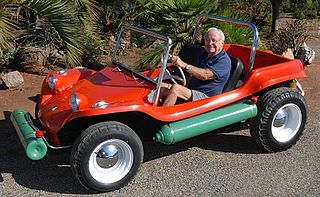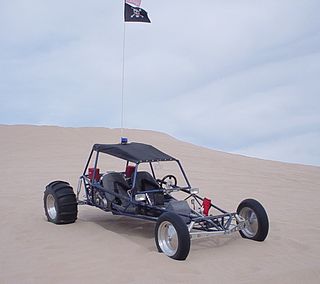Autozodiaco was an Italian car manufacturer located in Bologna, focusing mainly on dune buggies based on the VW Beetle. The company existed between 1968 and 1981. [1] [2]
California
[[File:Moto Zodiaco Tuareg 223-2 mit MotorILO-Motorenwerke Rockwell 1F250-1.jpg|thumb|250x250px|Moto Zodiaco Tuareg with ILO Rockwell 1F250-1 engine]] In the 1970s they produced the offroad motorbike Moto Zodiaco Tuareg. With large balloon tyres it was intended as a dune buggy.
The Moto Zodiaco was powered by a two-stroke single cylinder 227cc motor with 20bhp, (normally found in snowmobiles) and a pulley transmission (normally found in tractors). [3] The top speed was around 100 km/h.
The bike had a yank cord start but an electric starter was optional. It was available in colors: sunshine yellow, alpine white and red Verona.
In 1978 Autozodiaco sold the rights to construct a three-wheel micro car, renamed the All Cars Charly. It was similar in appearance to the Bond Bug and was powered by a 49cc moped engine. [4]

The Volkswagen Beetle—officially the Volkswagen Type 1, is an economy car that was manufactured and marketed by the German company Volkswagen (VW) from 1938 until 2003. It has a rear-engine design with a two-door body style and is intended for five occupants.

A dune buggy — also known as a beach buggy — is a recreational off-road vehicle with large wheels, and wide tires, designed for use on sand dunes, beaches, off-road or desert recreation. The design is usually a topless vehicle with a rear-mounted engine. A dune buggy can be created by modifying an existing vehicle or custom-building a new vehicle.

Aprilia is an Italian motorcycle manufacturer founded immediately after World War II in Noale, Italy, by Alberto Beggio. The company started as a manufacturer of bicycles and moved on to manufacture scooters and small-capacity motorcycles. In more recent times Aprilia has produced large sportbikes such as the 1,000 cc V-twin RSV Mille and the V4 RSV4.
Radio-controlled cars are miniature model cars, vans, buses, trucks or buggies that can be controlled from a distance using a specialized transmitter or remote. The term "RC" has been used to mean both "remote controlled" and "radio controlled". "Remote controlled" includes vehicles that are controlled by radio waves, infrared waves or a physical wire connection.

A Baja Bug is an original Volkswagen Beetle modified to operate off-road, although other versions of air-cooled Volkswagens are sometimes modified as well. Baja bugs often race in off road desert races such as the Baja 1000. There are different classes for bugs, namely class 11, class 5 1600, and class 5 unlimited. According to desert racing association Score International, class 11 is a stock VW beetle with modifications limited to ground clearance and strength. Class 5 1600 rules state that a 1600 cc VW engine must be used and the car must have the exterior appearance of a "baja bug" with body modification limited to whatever cutting is needed to install a consumer baja kit. Class 5 unlimited is any 4 cylinder VW-style engine, and it must have Baja-style fenders and side panels, and VW-style suspension.

The Volkswagen Type 3 is a compact car manufactured and marketed by Volkswagen from 1961 to 1973. Introduced at the 1961 Frankfurt International Motor Show, the IAA, the Type 3 was marketed as the Volkswagen 1500 and later as the Volkswagen 1600, in two-door Notchback, Fastback, and Variant body styles, the latter marketed as the 'Squareback' in the United States.

In automotive design, an RR, or rear-engine, rear-wheel-drive layout places both the engine and drive wheels at the rear of the vehicle. In contrast to the RMR layout, the center of mass of the engine is between the rear axle and the rear bumper. Although very common in transit buses and coaches due to the elimination of the drive shaft with low-floor buses, this layout has become increasingly rare in passenger cars.

Homebuilt machines are machines built outside of specialised workshops or factories. This can include different things such as kit cars or homebuilt computers, but normally it pertains to homebuilt aircraft, also known as amateur-built aircraft or kit planes. Homebuilt aircraft or kit cars are constructed by amateurs. Homebuilt computers have been built at home for a long time, starting with the Victorian era pioneer Charles Babbage in the 1820s. A century later, Konrad Zuse built his own machine when electromechanical relay technology was widely available. The hobby took off with the early development of microprocessors and, since then, many enthusiasts have constructed their own computers. A homebuilt vehicle is a wider concept than a kit car. A homebuilt vehicle is a motor vehicle built by an individual instead of a manufacturer. These machines may be constructed "from scratch", from plans, or from assembly kits. Outside of the United States people wishing to build such complex machinery often have no professional networks to rely on for spare parts, plans, or advice in the matter and therefore have to rely on their ingenuity and intuition in order to build a machine that works.

Gurgel Motores was a Brazilian automobile manufacturer, named after its founder João do Amaral Gurgel. The company was founded in 1969 and first specialised in buggies and off-road vehicles. Early models were fiberglass bodies installed on Volkswagen Beetle chassis and machinery, but VW bodies and chassis were later replaced by a unique solution made of Plasteel, which consists of fiberglass and steel joined, a system patented by Gurgel. Gurgel also introduced Brazil's first fully domestically designed and manufactured car, the BR-800.

The Meyers Manx dune buggy is a small recreationally-oriented automobile, designed initially for desert racing by Californian engineer, artist, boat builder and surfer Bruce F. Meyers. It was produced by his Fountain Valley, California company, B. F. Meyers & Co. from 1964 to 1971, in the form of car kits applied to shortened chassis of Volkswagen Beetles. The car line dominated dune racing in its time, breaking records immediately, and was eventually also released in street-oriented models, until the company's demise due to tax problems after Meyers's departure. New vehicles inspired by the original Manx buggy have been produced by Meyers's re-founded operation, Meyers Manx, Inc., since 2000. The name and cat logo of the brand derives from the Manx cat, by virtue of the tailless breed's and the shortened vehicle's truncated "stubbiness".

A sandrail, also called a sand rail, rail, or sand car, is a lightweight off-road motor vehicle specifically built for traveling in sandy terrain. Similar in some respects and often mistakenly referred to as a dune buggy or sand car, a sandrail is a different type of speciality vehicle. Sandrails are popularly operated on actual sand dunes. Sandrails can be driven on other types of terrain but are designed specifically for sand.

The Volkswagen Type 181 is a two-wheel drive, four-door, convertible, manufactured and marketed by Volkswagen from 1968 until 1983. Originally developed for the West German Army, the Type 181 also entered the civilian market as the Kurierwagen in West Germany, the Trekker in the United Kingdom, the Thing in the United States (1973–74), the Safari in Mexico and South America, and Pescaccia in Italy. Civilian sales ended after model year 1980.

The Volkswagen Country Buggy is a small utility vehicle designed and built by Volkswagen in Australia. It used parts from the existing Type 1 and Type 2. Production ran from 1967 to 1968. A derivative of the Country Buggy called the Sakbayan was built in the Philippines for several years until 1980.

In automobile design, a rear-engine design layout places the engine at the rear of the vehicle. The center of gravity of the engine itself is behind the rear axle. This is not to be confused with the center of gravity of the whole vehicle, as an imbalance of such proportions would make it impossible to keep the front wheels on the ground.
Fiberfab was an American automotive manufacturer established in 1964. Starting with accessories and body parts, they progressed to making kit cars and fully assembled automobiles. They became one of the longest lasting kit car manufacturers.
Puma was an Italian automobile company which specialized in kit cars and was active from the 1970s to 1990s. Its headquarters were in Via Tiburtina, Rome.

The ILO-Motorenwerke GmbH 2-stroke motor company in Pinneberg, Germany existed from 1911 to 1990 and was one of the biggest manufacturers of two-stroke engines in Germany. The term ‘ILO’ comes from the constructed language Esperanto and means "tool". In 1959 it was sold to Rockwell Manufacturing Company.

The Siva Motor Car Company was a British manufacturer of automobiles active from 1970 to 1976.